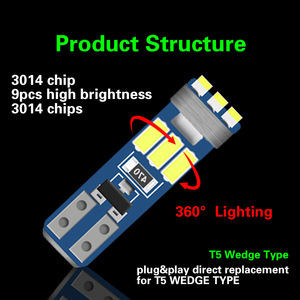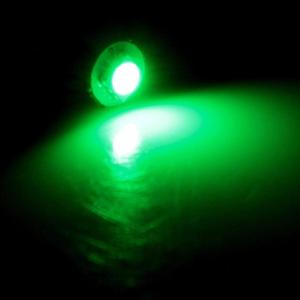(200 products available)
































































































































































































































An instrument cluster light bulb is an essential component of a vehicle's dashboard. It serves to illuminate the instrument cluster, making it easier for drivers to read gauges and indicators, especially at night or in low-light conditions. There are several types of instrument cluster light bulbs, each with unique characteristics and applications.
Incandescent Bulbs
These are traditional cluster light bulbs that use a filament and produce light when electricity passes through. They are known for their warm glow but are less energy-efficient and have a shorter lifespan compared to other options.
LED Bulbs
These are the most common types of instrument cluster lights. They are energy-efficient, have a long lifespan, and are available in various colors. Their brightness and durability make them ideal for instrument cluster lighting.
Cold Cathode Fluorescent Lamps (CCFLs)
These are used for instrument cluster lighting and provide even illumination. They are brighter than incandescent bulbs and offer better color quality but are being gradually replaced by LEDs due to their lower energy efficiency.
Electroluminescent Panels
These are used in some modern dashboards to provide backlighting. They offer a uniform glow and can be used for indicators and text but are less common than LEDs.
Halogen Bulbs
These are used in some vehicle dashboards and are known for their bright, focused light. They are often used for supplementary lighting in addition to instrument cluster illumination.
Super Bright LEDs
These are a specialized, high-intensity LED cluster light that provides extremely bright light. They are used in applications requiring high visibility and brightness.
Replaceable LED bulbs
These are designed to be directly swapped for traditional incandescent bulbs. They come in various sizes and shapes, making it easy to upgrade the instrument cluster lighting to LED technology.
Customizable RGB LEDs
These are multi-color LEDs that can be programmed to emit various colors. They allow for customization of the instrument cluster lighting to match preferences or themes.
Below are some of the specifications to consider when buying an instrument cluster light bulb for sale:
Voltage and wattage
Check the voltage and wattage of the instrument cluster light bulb. It should match the current one used in the vehicle. The bulbs are available in different wattages ranging from 1 watt to 5 watts. A higher wattage bulb produces more light.
Base type
Check the base type of the bulb. It should match the one required by the instrument panel. Common base types include wedge and bayonet.
Color temperature
Consider the color temperature of the light emitted by the bulb. Most instrument cluster bulbs emit a cool white light with a color temperature of 5000K to 6500K. This matches the lighting used in most vehicle interiors.
Dimmer compatibility
Some instrument cluster bulbs are not compatible with the dimmer circuit. This causes them to flicker or burn out quickly. If the bulbs need to be used with a dimmer, look for ones that are specifically marked as dimmer compatible.
Service life
Check the expected service life of the bulb. Most LED instrument cluster light bulbs have an average lifespan of 50,000 hours. Incandescent bulbs, on the other hand, have a lifespan of 1,000 hours.
Brightness
Consider the brightness of the instrument cluster bulb. It should be bright enough to illuminate the dashboard without causing glare. The brightness is usually given in lumens with a higher value indicating a brighter light.
Size and shape
Check the size and shape of the instrument panel light bulbs. It should fit into the available sockets on the dashboard or instrument cluster.
Maintaining the instrument cluster light bulb is an important part of vehicle maintenance. This ensures the dashboard lights continue to work and provide visibility. Below are some of the recommended maintenance practices:
Choosing the right instrument cluster light bulbs for a vehicle requires careful consideration of several factors to ensure compatibility, performance, and safety. Here are some key aspects to keep in mind:
Replacing an instrument cluster bulb is a straightforward process that can be done with basic tools. Here's a step-by-step guide on how to do it:
Gather the necessary tools
Find a Phillips screwdriver or a Torx screwdriver, depending on the instrument panel's screws, and get a flathead screwdriver. Also, have a pair of needle-nose pliers and a flashlight or work light.
Find the access point
Search for a cover plate or access panel on the dashboard or around the instrument cluster. This may require removing a few screws or gently prying off clips.
Remove the instrument cluster
Instrument clusters are usually held in place with screws. So, use the appropriate screwdriver to remove the screws and carefully pull the instrument cluster away from the dashboard. Be cautious not to damage any surrounding trim or components.
Locate the burned-out bulb
Once the instrument cluster is accessible, find the back of the cluster and search for the bulb that needs replacement. Refer to the owner's manual or service manual for the instrument cluster's bulb locations and types.
Remove and replace the bulb
Carefully twist or pull the bulb out of its socket. Use needle-nose pliers if the bulb is difficult to remove. Then, install a new bulb of the same type and wattage. It's essential to use the correct replacement bulb to avoid damage to the instrument cluster or electrical system.
Reassemble the instrument cluster
After replacing the bulb, reinstall the access panel or cover plate and secure it with screws. Then, carefully push the instrument cluster back into place and secure it with its screws.
Test the new instrument cluster light
Before finalizing everything, turn on the vehicle's ignition and test the new instrument cluster light to ensure it's working correctly. If it doesn't light up, double-check the bulb installation and connections.
Q1: Can one use LED bulbs in place of regular incandescent instrument cluster light bulbs?
A1: Yes, LED bulbs can be used as replacements. They last longer and are more energy efficient than regular incandescent bulbs. However, ensuring the LEDs are compatible with the vehicle's instrument cluster is necessary.
Q2: What color should instrument cluster lights be?
A2: While there are no strict rules, it's essential that the dashboard lights are not too bright or distracting. Traditionally, green and amber are used because they are easy on the eyes. Ultimately, it's up to the user’s preference while also considering readability and comfort.
Q3: How long does it take to replace an instrument cluster light bulb?
A3: The time can vary depending on the vehicle and the technician's experience. It can take anywhere from 30 minutes to a few hours in most cases. It's important to be patient and careful to avoid damaging other parts of the dashboard.
Q4: Are all instrument cluster lights the same across different vehicles?
A4: No, they can vary in type, color, and brightness depending on the vehicle. Some have LEDs, others have incandescent bulbs, and some have color-changing options. It's essential to check what type is in the vehicle and match replacements accordingly.
Q5: Do instrument cluster lights flash as a warning signal?
A5: Yes, they can. If an issue is detected in the vehicle, the instrument cluster lights can flash to grab attention. It indicates that something needs immediate attention. It's crucial to stop and check what the warning light is trying to convey.